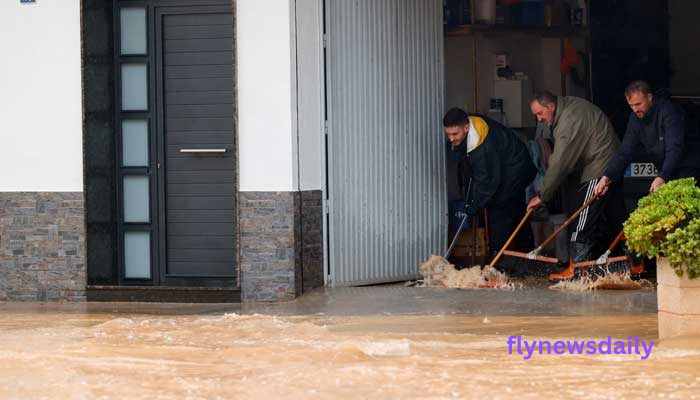
In recent years, Spain has faced significant challenges as torrential rains continue to impact various regions of the country, resulting in devastating floods. The consequences of these intense weather events are far-reaching, affecting communities, infrastructure, agriculture, and overall economic stability. In this article, we examine the causes, impact, and potential solutions to Spain’s ongoing flood crisis.
Why Are Torrential Rains So Severe in Spain?
Climate and Geographic Factors
Spain’s unique geography, combined with its climate variability, makes it highly susceptible to extreme weather events. The Mediterranean climate, which covers much of eastern and southern Spain, is characterized by hot, dry summers and mild, wet winters. When autumn arrives, the sea remains warm while cooler air flows in from the north, creating the ideal conditions for what is known as the “cold drop” or “gota fría.” This meteorological phenomenon often leads to intense rainfall within a short time span, overwhelming rivers and drainage systems, particularly in regions with little vegetation.
The risk is exacerbated by Spain’s diverse terrain, which includes coastal plains, mountainous regions, and river valleys. The runoff from heavy rains quickly travels downhill, converging in valleys and low-lying urban areas, causing flash floods that strike with little warning.
The Influence of Climate Change
Climate change is intensifying the frequency and severity of torrential rains worldwide, and Spain is no exception. According to recent climate models, the Iberian Peninsula is expected to see a rise in extreme rainfall events as global temperatures increase. The warming of the Mediterranean Sea adds more moisture to the atmosphere, which can result in heavier rainfall. Additionally, Spain’s drought-stricken landscapes are less capable of absorbing large amounts of rain, worsening flood risks.
Impacts of Torrential Rains and Flooding on Spain
Loss of Life and Property
Floods can be deadly, and Spain has witnessed tragic loss of life from flash floods, especially in densely populated areas and during peak tourism seasons. The impact on property is immense, with thousands of homes and businesses left devastated each year. Communities in flood-prone areas often face displacement, while the long recovery process can impose heavy psychological and financial burdens.
Economic Consequences
The economic impact of floods in Spain is significant. Apart from the direct costs of rebuilding infrastructure and homes, floods disrupt business operations, leading to lost productivity. Insurance premiums skyrocket in high-risk areas, and local governments struggle to allocate resources for flood mitigation and recovery. The agricultural sector, a vital part of Spain’s economy, also suffers from the destruction of crops, livestock losses, and soil erosion, further straining economic resources.
Damage to Infrastructure
Public infrastructure, including roads, bridges, railways, and utilities, often bears the brunt of flood damage. Repairing and rebuilding these facilities is costly and time-consuming, further stretching regional budgets. Transportation networks suffer extensive disruptions, affecting not only local travel but also the supply chain for goods and services, which can lead to higher costs and longer delays for essential products.
Environmental Impacts
Floods disrupt local ecosystems, washing away soil and vegetation while introducing pollutants and waste into rivers and coastal areas. Erosion and sediment displacement can harm biodiversity, and standing water from floods creates breeding grounds for disease-carrying insects, which pose public health risks. Long-term environmental consequences may include altered landscapes, reduced fertility of agricultural lands, and increased desertification in vulnerable areas.
Regions Most Affected by Spain’s Flood Crisis
Murcia and Valencia
The regions of Murcia and Valencia are highly susceptible to flooding due to their location along Spain’s Mediterranean coast. The dense population, combined with the frequent occurrence of “gota fría” events, has led to severe flooding episodes that strain local emergency response systems.
Catalonia
Catalonia faces significant flood risks, particularly in areas close to the Pyrenees. Intense rains in the mountains lead to rapid water accumulation in river valleys, often resulting in flash floods. In recent years, Catalonia has experienced multiple floods that have caused widespread damage to its infrastructure and housing.
Andalusia
Andalusia, known for its agricultural productivity, is another region frequently affected by heavy rains and flooding. Low-lying farmland is particularly vulnerable, and when floods occur, the destruction of crops and soil degradation threaten the livelihood of farmers and the broader agricultural supply chain.
Spain’s Response and Measures to Address Flood Risks
Emergency Response and Evacuation Protocols
In response to the recurring flood crises, Spanish authorities have improved emergency preparedness measures. Local governments coordinate with the National Emergency Services to deploy first responders and provide evacuation protocols. Early warning systems, including SMS alerts and media broadcasts, are being used to alert residents in flood-prone areas, although there is still room for improvement in ensuring all vulnerable populations receive timely warnings.
Infrastructure Upgrades
Spain has made significant investments in infrastructure aimed at mitigating flood impacts. Flood barriers, storm drains, and river channeling projects are being implemented in many high-risk areas. However, critics argue that these measures are often insufficient or only serve as temporary solutions. There is growing recognition of the need to develop resilient infrastructure capable of withstanding the worsening effects of climate change.
Sustainable Urban Planning
Cities across Spain are beginning to adopt more sustainable urban planning practices to reduce flood risks. These include creating permeable surfaces in urban areas to allow better water absorption, enhancing green spaces to prevent runoff, and revising building codes in flood-prone zones. Green infrastructure, such as rain gardens and retention basins, is becoming increasingly popular as cities strive to adapt to the challenges posed by climate change.
Reforestation and Land Management
To combat soil erosion and increase water absorption capacity, Spain has launched reforestation initiatives and improved land management practices in areas prone to flooding. By restoring vegetation cover and promoting sustainable agriculture, Spain aims to reduce the speed and volume of runoff water, lowering the risk of flash floods in vulnerable regions.
Challenges and Future Directions
Limited Resources and Economic Constraints
While Spain has made strides in flood mitigation, limited financial resources and budget constraints often delay or limit the scale of these initiatives. Rural and less economically developed areas may lack the funds required for necessary infrastructure upgrades or sustainable land management practices.
Need for Climate Adaptation Strategies
As climate change accelerates, it’s becoming clear that traditional flood control measures may no longer be sufficient. Spanish policymakers are urged to adopt comprehensive climate adaptation strategies, which include both preventive measures and strategies to improve community resilience. Integrating climate risk assessments into urban planning, strengthening cross-regional cooperation, and educating the public about flood preparedness are essential for reducing future risks.
Community Awareness and Engagement
Building community awareness around flood risks and the importance of emergency preparedness is essential. Local governments are working to improve communication and education efforts, ensuring residents understand the risks and know how to respond during a flood event. Community-driven initiatives, such as neighborhood emergency plans and volunteer response teams, can enhance resilience at a grassroots level.
Conclusion
Spain’s flood crisis underscores the urgent need for comprehensive and forward-thinking approaches to flood management. From improving emergency response systems to investing in resilient infrastructure and embracing sustainable urban planning, there are numerous ways Spain can address these recurring challenges. Addressing the flood crisis requires collaboration across government, businesses, and communities, as well as significant investment in both infrastructure and education.



